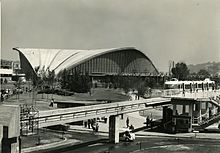Franco Levi

Franco Levi (born September 20, 1914 in Turin , † January 10, 2009 ) was an Italian civil engineer. He is considered one of the fathers of the Eurocodes in construction.
biography
Levi studied civil engineering at the École Centrale in Paris and at the Polytechnic in Turin, graduating in 1937. He was then assistant to Gustavo Colonetti . In 1938 he had to go into exile to France and then to Switzerland, because as a Jew he was persecuted by the fascists. In 1944 he was a lecturer in Lausanne. In 1945 he was back at the Polytechnic in Turin and continued his research. In 1949 he became a professor. During this time he was director of the Italian national research council CNR in Turin. He was a professor at the Polytechnic in Turin, where he was director of the Institute for Structural Engineering (from 1969) and Soil Mechanics. He also taught at the University of Venice from 1962 to 1969. In 1989 he retired. He also taught at the Center des Hautes Études de la Construction in Paris.
He carried out basic research, for example on prestressed concrete (from 1938), application of the theory of plasticity and creep of concrete, and in doing so made a contribution to preparing and applying the research results for engineering practice. For the Expo 1961 he designed the Torino Palavela in Turin, a sports hall. Other buildings were large dry docks and the redesign of the Lingotto district of Turin with Renzo Piano .
After the European Committee for Concrete (Comité Européen du Béton, CEB) was founded in 1953, he was its President from 1957 to 1968. The aim was to use the ultimate load method based on plastic deformations in the ultimate limit state and probabilistic safety criteria ( partial safety concept , partial safety factors) for a harmonization of the standards for reinforced concrete. The first two standard recommendations of the CEB came out under his dynamic leadership.
From 1966 to 1970 he was President of the FIP (Fédération Internationale de la Précontrainte), the international society for prestressed concrete. When the CEB recommendations for the basis of Eurocode 2 (for concrete structures) were made in 1979, Levi became chairman of the committee responsible for the publication of Eurocode 2 (which it was 1979 to 1990), which led to its publication in 1988. He was also significantly involved in EC 1, 3, 6 and 8. Here, too, the ultimate load method and the partial safety factors became the basis for standardization.
In 1989 he received the Emil Mörsch Medal and he received the Trasenster, Freyssinet , Caquot and Torroja medals. In 1986 he became a resident full member (socio nazionale residente) of the Academy of Sciences in Turin , of which he had been a corresponding member since 1974. He received honorary doctorates from the University of Liège, the University of Waterloo and the University of Venice. In 1976 he received the Italian gold medal for services to science, culture and art (Medaglia d'oro ai Benemeriti della Scuola, della Cultura e dell'Arte).
From 1962 he was on the board of directors of the Italian Society for Prestressed Concrete (Associazione Nazionale Cemento Armato Precompresso, ANICAP) and from 1984 to 1987 he was head of the Italian Society for Reinforced and Prestressed Concrete (Associazione Italiana Calcestruzzo Armato e Precompresso, AICAP). In 1999 he became an honorary member of the AICAP.
literature
- Giorgio Macchi: Commemoration . In: Acc. Sc. Torino. Atti Scienze Fisiche 144 (2010), pp. 25–33 ( download )
Individual evidence
Web links
| personal data | |
|---|---|
| SURNAME | Levi, Franco |
| BRIEF DESCRIPTION | Italian civil engineer |
| DATE OF BIRTH | September 20, 1914 |
| PLACE OF BIRTH | Turin |
| DATE OF DEATH | January 10, 2009 |